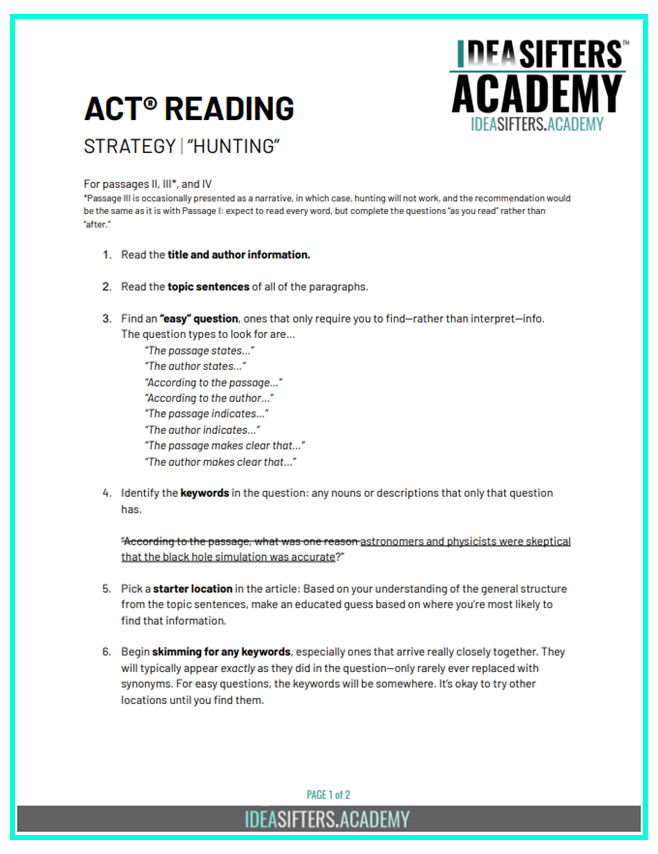March 21st, 2022 at 8:25 pm EDT
Looking for a way to save time on the ACT® Reading section? If the SAT® is the test that creates difficulty through complexity, then the ACT® is the test that creates difficulty through “hurry.” The good news is that, regardless of how fast of a reader you are, many of the ACT® Reading questions are literal enough that you can turn the odds on the house by “hunting” primarily, and only “reading” secondarily. Let’s take a look at how.
STRATEGY | “HUNTING”
For passages II, III*, and IV
*Passage III is occasionally presented as a narrative, in which case, hunting will not work, and the recommendation would be the same as it is with Passage I: expect to read every word, but complete the questions “as you read” rather than “after.”
1. Read the title and author information.
2. Read the topic sentences of all of the paragraphs.
3. Find an “easy” question, ones that only require you to find—rather than interpret—info.
The question types to look for are…
- “The passage states…”
- “The author states…”
- “According to the passage…”
- “According to the author…”
- “The passage indicates…”
- “The author indicates…”
- “The passage makes clear that…”
- “The author makes clear that…”
4. Identify the keywords in the question: any nouns or descriptions that only that question has.
According to the passage, what was one reasonastronomers and physicists were skeptical that the black hole simulation was accurate?
5. Pick a starter location in the article: Based on your understanding of the general structure from the topic sentences, make an educated guess based on where you’re most likely to find that information.
6. Begin skimming for any keywords, especially ones that arrive really closely together. They will typically appear exactly as they did in the question—only rarely ever replaced with synonyms. For easy questions, the keywords will be somewhere. It’s okay to try other locations until you find them.
7. Once you find the keywords, read nearby.
But astronomers and physicists were skeptical… The data the computer simulation processed into images came from merely four black holes, all of which were relatively similar in size. Meanwhile, there may be as many as 100 billion black holes in the universe.
8. Compare the answer choices and the area you just read. The one that has the most words matched is likely the answer. We call this strategy “Hunting” because it doesn’t actually involve much actual reading—you’re hunting for word matches only.
But astronomers and physicists were skeptical… The numbers the computer simulation processed into images came from merely four black holes, all of which were relatively similar in size. Meanwhile, there may be as many as 100 billion black holes in the universe.
✓ a. The simulation processed merely four sets of data that were all similar.
9. Draw a big check over the question to signal that you’ve finished it.
10. Repeat for all easy questions.
11. Complete vocabulary questions: scratch out the word in the reading, in the actual line the question mentions. Then reread as though there were a “blank” where the vocabulary word is. Your instinct will often give you an answer to match to the options. Do not read the answers first—they’re designed to swing you in wrong directions.
12. Complete any inference or “main idea of paragraph” questions by reading the paragraphs referenced. You will have saved time with hunting other questions, so take your time and read well before you check out your options.
13. Complete any main idea questions about the whole passage last. They are often presented first—a trap from the test makers. If you complete them last instead, you’ll be far more familiar with the passage, and far more prepared for these questions.
Ryan Derenberger is a freelance journalist and editor, a Journalism and AP Language teacher at Whitman HS in Bethesda, MD, and the founder of 'The Idea Sift.'



